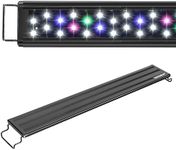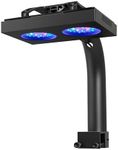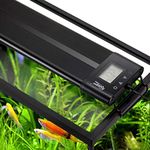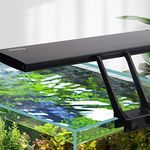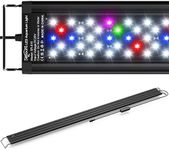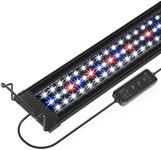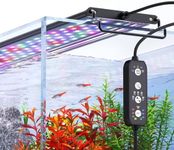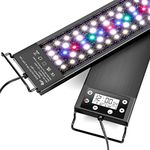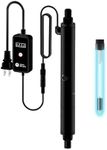Buying Guide for the Best LED Aquarium Lights
Choosing the right LED aquarium lights is crucial for the health and well-being of your aquatic life. LED lights are energy-efficient, long-lasting, and can provide the necessary light spectrum for both freshwater and saltwater aquariums. When selecting LED lights, consider the type of aquarium you have, the needs of your aquatic plants and animals, and the aesthetic you want to achieve. Here are some key specifications to help you make an informed decision.Light SpectrumThe light spectrum refers to the range of light wavelengths emitted by the LED lights. This is important because different aquatic plants and animals require specific wavelengths for optimal growth and health. Full-spectrum lights, which include all colors of the spectrum, are ideal for most aquariums as they mimic natural sunlight. If you have a planted aquarium, look for lights that provide a good balance of blue and red wavelengths, as these are essential for photosynthesis. For coral reefs, lights with higher blue wavelengths are preferred. Choose a light spectrum that matches the needs of your aquarium inhabitants.
Light IntensityLight intensity, measured in lumens or PAR (Photosynthetically Active Radiation), indicates how much light is being emitted. This is important because different aquatic environments require different light intensities. Low light intensity (up to 30 PAR) is suitable for low-light plants and fish-only tanks. Medium light intensity (30-60 PAR) is good for most planted aquariums. High light intensity (60+ PAR) is necessary for high-light plants and coral reefs. Consider the type of plants and animals in your aquarium and choose a light intensity that supports their growth and health.
Color TemperatureColor temperature, measured in Kelvin (K), describes the color appearance of the light. This is important for both the aesthetic of your aquarium and the health of your aquatic life. Lower color temperatures (around 6,500K) produce a warm, yellowish light that is suitable for freshwater aquariums. Higher color temperatures (10,000K and above) produce a cool, bluish light that is ideal for saltwater aquariums and coral reefs. Choose a color temperature that enhances the natural colors of your aquarium and meets the needs of your aquatic plants and animals.
AdjustabilityAdjustability refers to the ability to control the brightness, color, and timing of the LED lights. This is important for creating a natural day-night cycle and for adjusting the light to meet the specific needs of your aquarium. Some LED lights come with built-in timers, dimmers, and color controls, allowing you to customize the lighting. If you have a diverse aquarium with different lighting needs, or if you want to simulate natural lighting conditions, look for LED lights with high adjustability. This will give you more control over the environment and help maintain the health of your aquatic life.
Waterproof RatingThe waterproof rating indicates how well the LED lights are protected against water. This is important because aquarium lights are exposed to moisture and splashes, and a good waterproof rating ensures the lights will last longer and remain safe to use. Look for lights with an IP (Ingress Protection) rating of at least IP65, which means they are protected against water jets. Higher ratings, such as IP67 or IP68, offer even better protection and are suitable for more demanding environments. Choose a waterproof rating that matches the conditions in your aquarium to ensure durability and safety.
Energy EfficiencyEnergy efficiency refers to how much electricity the LED lights consume relative to the amount of light they produce. This is important for reducing energy costs and minimizing the environmental impact of your aquarium. LED lights are generally more energy-efficient than other types of aquarium lighting, but there can still be variations between different models. Look for lights with a high lumens-per-watt ratio, which indicates better energy efficiency. If you have a large aquarium or plan to keep the lights on for extended periods, choosing energy-efficient LED lights can save you money and reduce your carbon footprint.

